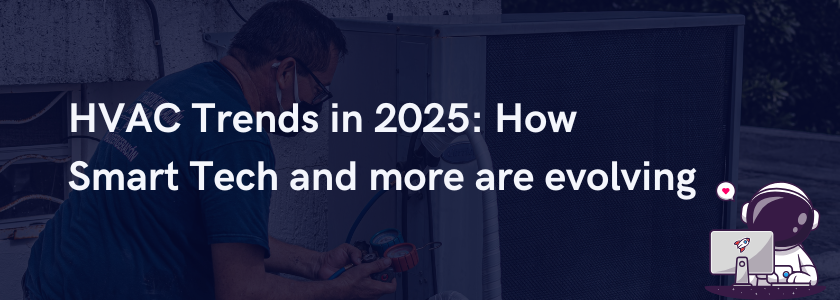The HVAC industry is going through some big changes. E-commerce, smart technology, and new demands from commercial clients are reshaping how businesses operate and compete. These shifts come with both challenges and opportunities, especially for companies ready to adapt.
The global HVAC market is expected to reach nearly $383 billion by 2030. This growth is driven by stricter energy regulations, new technologies, and a push for more sustainable systems. Businesses that stay ahead by embracing smart HVAC solutions and strengthening their online presence are more likely to stand out and bring in more customers.
In this guide, we’ll break down the top HVAC trends to watch in 2025 and share practical tips for:
- Suppliers navigating the shifting e-commerce landscape
- Contractors implementing smart HVAC technologies
- Building owners complying with new efficiency standards
Positioning your business ahead of these changes ensures a competitive edge and lasting success in the evolving HVAC market.
The Rise of HVAC E-Commerce
The HVAC industry is growing fast, with the global market expected to increase at a 6.4% annual rate through 2031. E-commerce is playing a major role in that growth, changing how HVAC businesses sell and operate.
Online HVAC equipment sales surged in 2024. Digital platforms have become a key part of the industry, not just an added option. This shift is being driven by three main factors:
- Buyers expect clear, retail-style transparency
- Contractors are using online platforms to source equipment
- Post-pandemic habits have made contactless purchases the norm
Why HVAC Buyers are Moving Online
More HVAC buyers—homeowners and commercial clients—prefer to do their research before making a purchase. Over 80% start their buying journey online. They want to compare features, check prices, and read reviews before making a decision.
E-commerce platforms meet these needs by offering:
- Easy access to product details
- Side-by-side comparisons of efficiency ratings
- Real customer reviews that build trust
This is especially helpful for replacement systems, where buyers often know exactly what they’re looking for and want a quick, reliable way to buy it.
Solving the Installation Challenge
More customers are buying HVAC systems online, but installation remains one of the biggest challenges. To address this, retailers are finding practical ways to simplify the process:
- Partnering with local contractors to offer bundled installation services
- Providing virtual consultations to confirm system compatibility
- Using augmented reality tools to assist with accurate measurements
These strategies help bridge the gap between online convenience and in-person service, creating a smoother experience for customers.
Winning Strategies for HVAC E-Commerce
Leading HVAC companies know that e-commerce requires a different approach than traditional sales. They combine technical expertise with digital tools to meet rising online demand and improve the customer experience.
Product Listings that Convert
Modern buyers expect product pages that are informative and easy to understand. The most effective listings include:
- Clear efficiency ratings
- 3D visualizations of HVAC systems
- Videos showing how installations work
Some retailers go a step further by adding interactive sizing tools to help customers choose the right system for their space. What makes these listings stand out is their ability to present complex information in a simple, accessible way.
Pricing Models for the Digital Age
Many suppliers are moving away from fixed MSRP pricing and adopting more flexible strategies. Examples include:
- Dynamic pricing based on seasonal trends and regional demand
- Subscription plans for ongoing maintenance and service
- Bulk purchasing options with tiered discounts for commercial buyers
These models provide more value to customers and help HVAC businesses build recurring revenue.
Logistics As a Competitive Advantage
HVAC e-commerce leaders are also improving how HVAC systems are delivered. They’ve built fulfillment processes that can handle large, bulky equipment while ensuring a smooth customer experience. Key features include:
- Fast delivery, often within the same week in metro areas
- White-glove services for handling and setup
- Climate-controlled storage for sensitive parts
These upgrades help reduce returns and increase customer satisfaction, which supports long-term growth.
Companies that view HVAC e-commerce as more than just an online storefront and instead as a full customer journey are better positioned to lead as the industry continues to evolve.
How AI Is Improving Efficiency and Performance
AI is transforming HVAC systems into smarter, more efficient tools. They now track data, spot issues early, and adjust automatically to save energy and reduce downtime.
This tech shift makes climate control more reliable, cost-effective, and easier to manage, benefiting both building owners and facility teams.
AI-Powered Predictive Maintenance
Modern HVAC systems now use real-time data to detect issues before they become costly problems. Using machine learning, they monitor things like vibration, refrigerant pressure, and energy usage to identify early signs of wear.
Facilities using this technology have seen up to 70% fewer equipment breakdowns and 40% fewer emergency service calls. The main benefits are avoiding downtime and scheduling maintenance that keeps operations running smoothly.
Self-Learning Climate Control
Today’s smart systems don’t just follow a preset schedule. They learn from how a building is used and adapt over time. By factoring in room occupancy, weather forecasts, and usage history, they make real-time adjustments across different zones.
Many commercial buildings using this technology report energy savings of 30% to 35%, all without sacrificing comfort. The longer the system runs, the smarter and more efficient it becomes.
The New Efficiency Standards Frontier
AI is also helping buildings stay compliant with stricter energy regulations like Seasonal Energy Efficiency Ratio (SEER) 2 and Heating Seasonal Performance Factor (HSPF) 2. Advanced heat pumps automatically adjust to changing climate conditions by fine-tuning compressor speeds, airflow, and defrost cycles. These systems are built for long-term performance and can stay up to date with future regulations through software updates, no hardware replacement needed.
Connecting With Smart Building Systems
The most advanced HVAC setups now work together with other building systems. They can communicate with lighting, window sensors, and even renewable energy sources to reduce energy use during peak hours or when clean energy is available.
Performance data is also sent directly to facility dashboards and sustainability reports, giving teams real-time insights and better control over building operations.
Emerging HVAC Technologies Redefining Smart Systems
AI is leading much of the smart HVAC conversation, but new innovations are quickly gaining ground. These emerging technologies aim to solve key challenges in energy efficiency, sustainability, and building adaptability.
Solid-State Cooling
Researchers at Purdue University have created solid-state heat pumps that use electrocaloric materials instead of traditional refrigerants. These systems are up to 40% more efficient than standard vapor-compression models, operate silently, and produce zero greenhouse gas emissions. If production costs drop as expected, this could be a game-changer for residential HVAC.
Hydrogen-Ready Combustion Systems
As the industry shifts toward decarbonization, hydrogen-compatible systems are becoming an important transition solution. Backed by a 2023 Department of Energy initiative, new hybrid boilers can run on hydrogen-natural gas blends. They feature redesigned burners that cut NOx emissions and still work with existing building infrastructure.
Self-Powered IoT Sensors
MIT researchers have developed sensors that power themselves using vibration from air moving through ducts. These devices send performance data without needing batteries or wiring. Early adopters report major savings on smart system maintenance, especially in retrofits where electrical access is limited.
Air Purification Innovations
New HVAC systems are integrating advanced air cleaning methods that were once only found in hospitals. One example is bipolar ionization, which removes up to 97% of airborne particles, including viruses as small as 0.1 microns. These systems actively treat the air throughout the entire ductwork, working alongside standard filters.
Zoning Technology
Zoning has come a long way from basic dampers. Today’s systems feature:
- Pressure-sensitive vents that adjust airflow
- Thermal imaging sensors for real-time occupancy tracking
- AI-driven controls that learn and adapt over time
These upgrades reduce energy waste and often pay for themselves in under three years. Many manufacturers are now linking zoning with full building automation systems, combining climate, lighting, and security into one smart platform.
Commercial HVAC Trends Reshaping Businesses
The commercial HVAC landscape is also changing quickly. New regulations, smarter technology, and the shift toward hybrid work have made HVAC decisions more important than ever. For building owners and facility managers, equipment choices now have long-term impacts on budgets, operations, and sustainability goals.
Decarbonization Is Driving Change
More commercial buildings are working toward net-zero emissions. The move away from high Global Warming Potential (GWP) refrigerants has led to increased use of low-emission options like R-32 and R-454B. Many companies now require electric heat pumps in new builds, and retrofits are following the same path to cut back on fossil fuel use.
This isn’t just about meeting new rules. HVAC upgrades are also helping businesses improve their sustainability image and meet investor expectations tied to Environmental, Social, and Governance (ESG) goals.
HVAC for Hybrid Workspaces
As offices become more flexible, HVAC systems need to be smarter. New zoning technology helps buildings respond to changing occupancy by adjusting airflow and ventilation room by room. Features like motion sensors and demand-based airflow help reduce energy use in areas that aren’t always in use.
These upgrades typically lead to 20% to 30% energy savings and make workspaces more comfortable, no matter how often they’re used.
Smarter Maintenance Strategies
IoT-connected HVAC systems are making maintenance more proactive. These systems send real-time performance data to monitoring platforms, allowing teams to:
- Schedule service based on actual system condition
- Catch performance issues early
- Automatically order replacement parts before breakdowns happen
This approach helps reduce unexpected downtime and extends the life of equipment, especially as systems become more advanced and harder to maintain manually.
Prioritizing Lifecycle Costs in HVAC Investments
More commercial buyers are thinking long-term. While high-efficiency systems can cost 15% to 20% more upfront, they often pay off with:
- Up to 50% lower energy use
- Lower maintenance costs
- Longer lifespan
- Points toward green building certifications
More companies are recognizing that HVAC systems directly impact employee comfort, utility expenses, and the overall value of the property, making thoughtful investment a smart business decision.
Regulatory and Sustainability Compliance
Global HVAC operations now navigate an increasingly complex web of environmental regulations and sustainability requirements. These aren’t mere guidelines—they’re reshaping product development cycles, installation practices, and long-term maintenance strategies across the industry.
The Global HFC Phasedown Accelerates
The Kigali Amendment aims to reduce high-GWP refrigerants by 85% by 2036. This is pushing manufacturers to update product lines with alternatives like R-454B and R-32, which have significantly lower environmental impact than R-410A.
New systems are also being designed to work more efficiently with these refrigerants. Timelines vary by region, with the European Union moving faster than the United States, but the direction is the same. Contractors must stay up to date on refrigerant certifications, as older systems may soon face limited service options and fewer available parts.
Rising Energy Efficiency Standards
Efficiency requirements continue to tighten. Standards like SEER2 and HSPF2 are just the start. Many commercial buildings are now subject to:
- Building codes that are updated every year
- Local laws that require electrification for new construction
- Performance benchmarking compared to similar properties
Meeting these standards can be challenging, but there are benefits. Properties with high efficiency ratings often command higher lease rates and attract tenants focused on sustainability.
The Incentives Landscape Becomes Strategic
Compliance can open the door to valuable tax credits and utility rebates.
Federal Tax Credit Optimization
Under the Inflation Reduction Act, qualified HVAC upgrades may receive a 30% tax credit. This applies to both equipment and labor, including related components. Projects that meet ASHRAE energy standards can qualify for up to $5 per square foot. Bundling upgrades, such as HVAC and solar panels, can increase the total benefit.
Tiered Utility Incentive Programs
Utility companies are offering structured rebate programs, including:
- Standard rebates of $300 to $500 per ton for meeting baseline efficiency
- Higher rebates of up to $1,200 per ton for systems that exceed requirements
- Payments for participating in demand-response programs
Businesses that schedule installations during utility budget cycles can often secure better rebates.
Accelerated Financial Structures
HVAC systems are typically depreciated over 39 years, but some components may qualify for faster schedules. Cost segregation studies can identify eligible items like modular units and smart controls. Section 179D also allows for immediate deductions, up to $1.80 per square foot, for certified energy-efficient retrofits.
Many companies are creating multi-year plans that align system upgrades with available incentives to improve financial returns on required improvements.
Sustainability Reporting as a Gamechanger
HVAC performance is now part of many corporate ESG reports. Investors and regulators expect detailed documentation, including:
- Tracking and timely repair of refrigerant leaks
- Energy usage reports adjusted for occupancy and weather
- End-of-life equipment recycling and disposal records
As reporting standards become stricter, HVAC systems are gaining more attention at the leadership level. The data collected from HVAC operations now contributes directly to how companies measure and report sustainability.
Data-Driven HVAC Advertising: The New Customer Acquisition Playbook
The HVAC industry’s shift to digital is changing how companies attract and convert customers. Targeted marketing strategies now play as big a role in growth as service quality and product selection. In 2025, companies that adapt their advertising approach will be better positioned to win new business in both residential and commercial markets.
Hyperlocal Visibility Through Optimized Listings
Google continues to prioritize proximity and relevance for service businesses. To show up in local searches, HVAC companies need to focus on Local SEO, which includes:
- Fully completed Google Business Profiles with defined service areas
- Regular posts featuring seasonal tips or maintenance content
- Active review management with responses that include relevant keywords (like “AC repair” or “heat pump installation“)
Listings with up-to-date information and customer engagement features, like booking buttons and Q&A, get more clicks and higher conversion rates.
Targeted Ads in a Privacy-Focused Landscape
With online privacy rules tightening, HVAC advertisers are shifting how they reach the right audience. Strong performers are moving away from third-party data and focusing on:
- Collecting first-party data through signups for service plans or tune-up reminders
- Launching weather-based ads tied to local temperature spikes
- Creating landing pages for specific services, such as furnace repair or ductless mini-split installs
These tactics lower lead costs and make ad budgets more efficient, especially as ad platforms limit broad targeting options.
Paid Advertising Built Around Performance
HVAC PPC marketing continues to evolve. HVAC companies that rely on old tactics are falling behind. Some of the key trends shaping results today include:
- Use of Google Performance Max campaigns to reach more potential customers
- Adjusting bids based on season and local weather trends
- Tracking calls and form submissions to measure true conversion performance
Automated bidding and machine learning tools can significantly improve ROI. These systems use multiple signals, like search behavior and location, to adjust campaigns in real time and prioritize higher-value leads.
As the industry becomes more competitive, strong marketing execution matters just as much as technical skill. HVAC contractors who understand both the service side and the digital side will be better equipped to grow their customer base and stay ahead of market shifts.
Future Predictions and Action Steps
The HVAC industry is entering a critical phase. Decisions made now will directly affect businesses’ performance over the next decade. Based on current trends and upcoming regulations, here’s what to expect and how to prepare.
2025–2030 Technology Adoption Outlook
Industry experts predict the following timeline for widespread adoption:
- 2025–2026: SEER2-compliant systems become standard, with more smart features included
- 2027–2028: Most systems transition to low-GWP refrigerants ahead of federal deadlines
- 2029–2030: Solid-state cooling begins entering commercial markets
The Department of Energy expects that by 2026, over half of all HVAC replacements will include advanced air purification in response to updated ASHRAE indoor air quality standards.
Immediate Action Items for HVAC Contractors
Within the next 12 months, HVAC businesses can take the following steps to stay competitive:
Residential Providers
- Complete NATE certification for smart HVAC systems
- Offer bundled maintenance plans that include air quality services
- Set up dynamic pricing models to respond to seasonal demand shifts
Commercial Specialists
- Train teams on refrigerant transition procedures, including R-454B and R-32 handling
- Invest in automated leak detection systems
- Start tracking energy benchmarks for managed buildings
Distributors
- Review inventory for high-GWP refrigerants and plan for phaseouts
- Build or enhance e-commerce platforms with live inventory updates
- Collaborate with manufacturers on take-back and recycling programs
Strategic Planning for Sustainable Growth
The most forward-thinking HVAC companies are already putting multi-year strategies in place. These three areas are becoming standard across the industry:
Ongoing Technician Training
Top-performing companies dedicate 5 to 7 percent of their revenue to training. This keeps technicians current on new technologies, systems, and refrigerants.
Equipment Replacement Planning
Detailed roadmaps are being built to guide equipment replacements over the next three years. These plans align with regulatory changes and available incentive programs.
Utility Demand Response Participation
More companies are enrolling in demand response programs to reduce grid strain and improve energy use. These programs offer new revenue opportunities and appeal to commercial clients focused on sustainability.
Lead the HVAC Industry’s Digital Transformation
In 2025, having the right equipment is only part of the equation. A clear digital strategy is just as critical for driving growth and staying competitive. Companies that invest in local SEO, targeted advertising, and smart marketing tools are better positioned to reach modern customers and increase market share.
Ready to grow your HVAC business with results-driven digital marketing?
Let’s turn these residential and commercial HVAC trends into real growth. Contact us for a free strategy session today!





